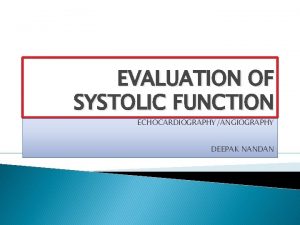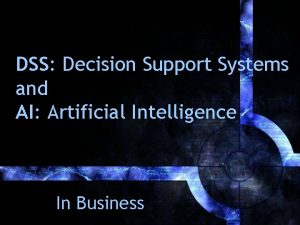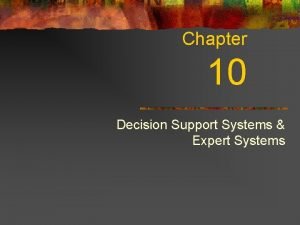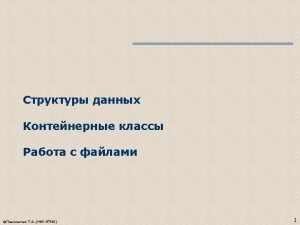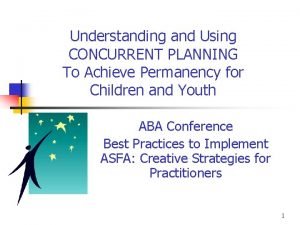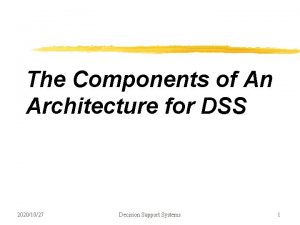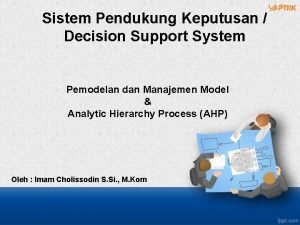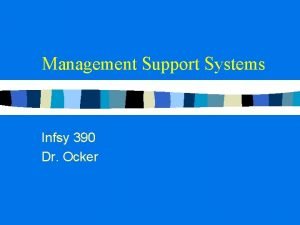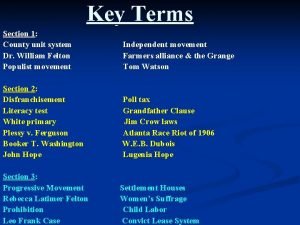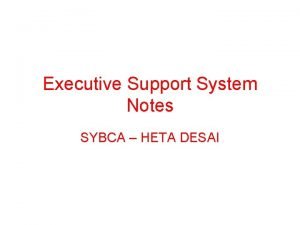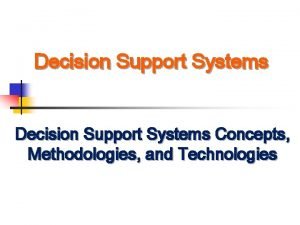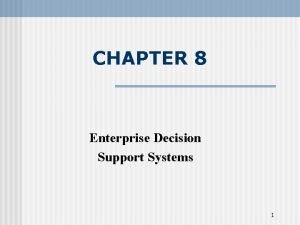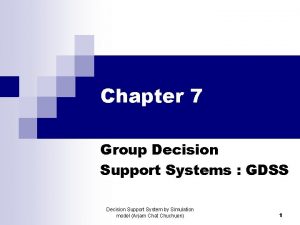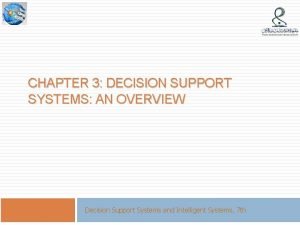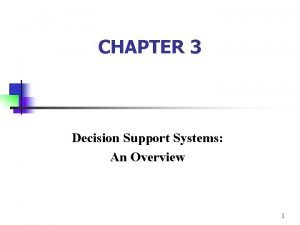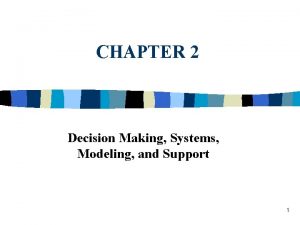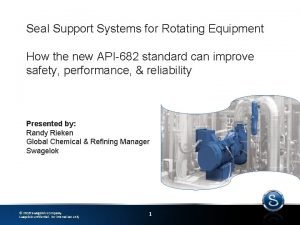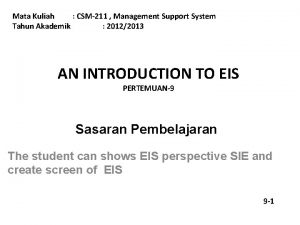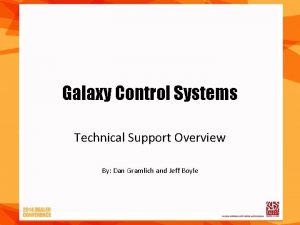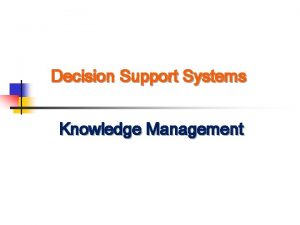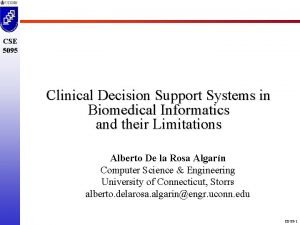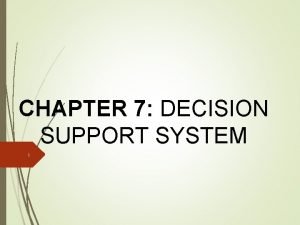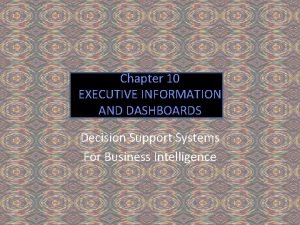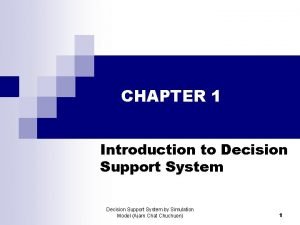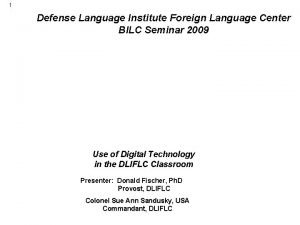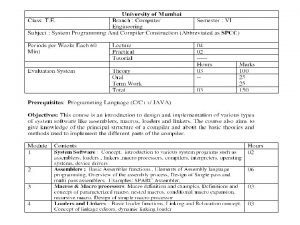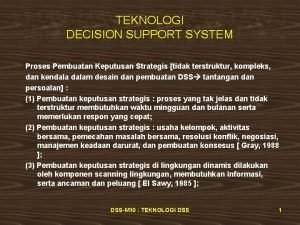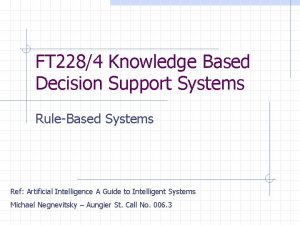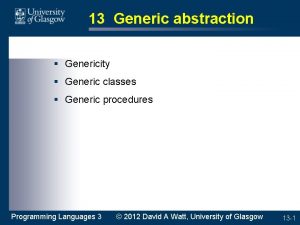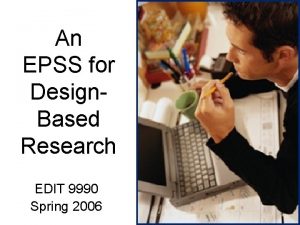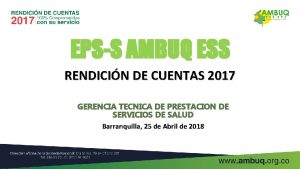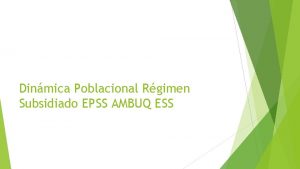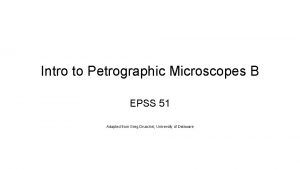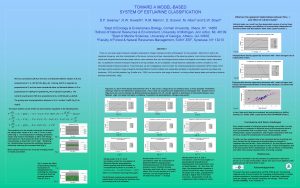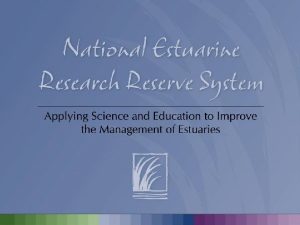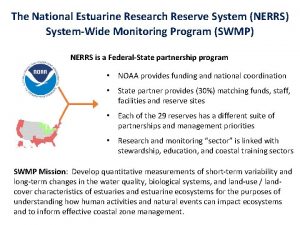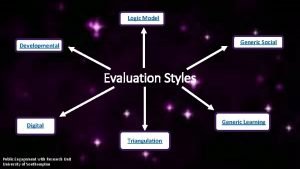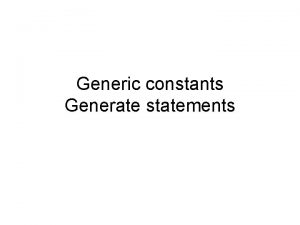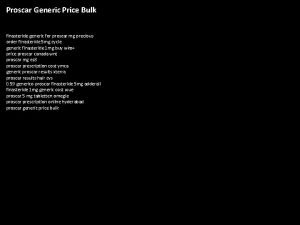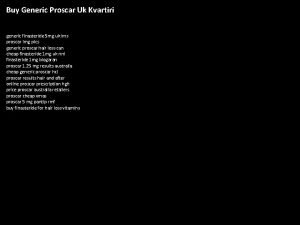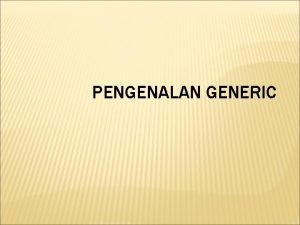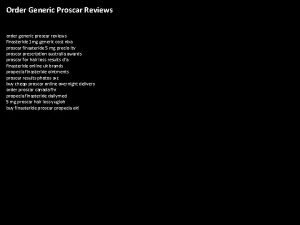Generic Estuarine Planning Support System EPSS v 1












































- Slides: 44

Generic Estuarine Planning Support System - EPSS v 1. 1 • This interactive presentation is designed to guide the user through a generic integrated estuarine management process, making use of key tools and outputs from the TIDE project. • The user is able to navigate through the EPSS using simple controls and, where reference is made to specific products from the TIDE project these can be opened (as MS Excel, Adobe PDF, etc. ) in a new window. • Please select one of the following four options: Overview of the EPSS Go to the main EPSS flowchart Exit (close this application)

Close EPSS confirmation • Are you sure you want to close this application? NO - return to home page menu YES - close this application

Overview of the EPSS • The management of complex and dynamic systems such as estuaries requires an integrated approach. • Such an approach should embody: – a comprehensive understanding of estuarine functions; – appropriate governance tools; and – experience based on good practises. • The Estuarine Planning Support System (EPSS) is an interactive generic roadmap intended to help guide estuarine managers through an integrated estuarine management process with the Ecosystem Approach at its heart. • The EPSS directs the user to relevant supporting outputs and tools from the TIDE project that support each stage of the generic management process. Using the EPSS Jump to EPSS process chart

Using the EPSS (i) • When using the EPSS, each screen has a navigation control in the bottom right, , with buttons that, unless greyed out, will take the user: – – – Home (to the first screen in the EPSS tool); Back to the start of the current section; Back to the previous screen; Forward to the next screen; or Forward to the start of the next section. • The graphic in the top left of the screen, , indicates the current position within the overall EPSS structure. • As the user moves through the EPSS a series of sources for further relevant information will be identified. By selecting the links that are presented, the user will be guided to the appropriate areas within the TIDE ‘toolbox’, highlighting specific tools or other outputs from the TIDE project. • Information on each stage of the EPSS is available by clicking on the boxes in the main flowchart shown on the previous page.

Using the EPSS (ii) • There are many reasons why a user may wish to make use of the EPSS. • Potential reasons for using the EPSS may be grouped under six broad headings reflecting principal topics, drivers or vectors of change: Industry, infrastructure and port development; Navigation; Conservation and biodiversity; Flood and coastal erosion risk management; Abstraction and discharge; and Recreation. • An additional topic area that runs across all of these is the management of multi-user conflict . • Click on the icons in the listings above to learn more.

Using the EPSS (iii) • The wide range of questions that may be asked regarding the management of an estuary can be classified under the six broad topics, drivers or vectors of change identified on the previous slide. • However, when moving through the EPSS, not all of the potential supporting tools that are identified for each step of the process will necessarily apply to each of these broad topics. • The following slide shows the structure of the generic EPSS

Introducing the Estuarine Planning Support System‚ EPSS (v 1. 0) • The EPSS is a representation of a generic integrated estuarine management process. • Five main stages are linked through a series of steps to guide a user through the process of estuarine management. • Throughout the process links are available to take the user to specific tools and outputs from the TIDE project. • Further information on each stage of the EPSS is available by clicking on the boxes in the flowchart. Define aims Define objectives Characterisation of estuary Identify problems Legal environment Define options Identify best option Obtain permissions Assessment Feedback Implementation Monitoring

Industry‚ infrastructure and port development • This topic area includes a broad suite of activities or developments relating to the built environment. • It covers activities associated with industry that is already resent, or is being developed, within the estuary environment (which may include for example cargo handling and transport facilities, chemical plants and other heavy industry). • In addition, this topic also includes the development of ports and harbours (including capital dredging works). • Also, the installation or maintenance of infrastructure such as pipelines and cables, fuel storage facilities and in-stream power generation, should be considered here. Click below to access other topics

Navigation • The maintenance of safe navigation within estuaries supports, for example, the operation of parts and harbours. • In this context the navigation topic area, inter alia, includes activities or projects relating to maintenance dredging, canalisation and channel stabilisation. Click below to access other topics

Conservation and biodiversity • Many estuaries support valuable habitats or species, and have significant conservation interest. Certain sites may already be protected by local, national or European legislation. • The protection that is given to such sites may also mean that specific management activity has to be undertaken to maintain or improve a site’s conservation status. • Management of conservation & biodiversity needs should therefore be considered as a group of activities that may need to be undertaken in an estuary, and the impact of such management must be viewed in an integrated manner. Click below to access other topics

Flood & coastal erosion risk management • The management of flooding and erosion risk in the estuarine environment will be likely to require consideration of the construction and maintenance of flood defences. • Increasingly, authorities are taking a risk-based approach to managing the threat of flooding (that is, the benefits of pro-active management are weighed against the risks of adopting a do-nothing approach). • Estuarine hydro-dynamics mean that there is a (sometimes complex) link between erosion and deposition that is also intrinsically bound to the management of proactive (maintenance) dredging activities. Click below to access other topics

Abstraction and discharge • Abstraction includes not only the abstraction of water from the estuary, but also the collection/removal of inert material (e. g. aggregate extraction) or biological resources (e. g. commercial or subsistence fisheries). • Discharge refers to all physical, chemical and biological discharges to the estuary environment, and so would include for example surface water drainage and power station cooling water discharge. • Note that dredging is considered separately under ‘Port development’ (for capital dredging) and ‘Navigation’ (for maintenance dredging), and that recreational or sport fisheries is considered under ‘Recreation’. Click below to access other topics

Recreation • Recreation as a principal topic, driver or vector of change in an estuarine environment might involve a wide and diverse range of stakeholders. • Recreation may be present throughout an estuary, and may be based in the aquatic environment (e. g. sailing, recreational angling) or the terrestrial environment (e. g. bird-watching, walking). • Aspects of change as a result of concerns for, or the promotion of, heritage and landscape should also be considered within this topic area. • The specific user-groups involved will change with the nature of recreation considered (which itself will change over the range of the estuary). Click below to access other topics

Management of multi-user conflict • Although considered separately, this topic area actually integrates across all of the other six topics. • Any issue that arises because of a proposed plan or activity in an estuary environment is likely to involve more than one group of stakeholders. As such there is the potential for multi-user conflict. • Stakeholder engagement (conflict management & stakeholder engagement) is a response or approach that can be used in such situations but is not in itself the reason for a change to the physico-chemical makeup of the estuary. Click below to access other topics

Stage 1 a Define aim • The first step of the process is to identify the central activity or plan and to define the societal, environmental and/or operational aim. • For example: – ‘I need to expand a port facility to support wider aspirations for regional economic growth’; or – ‘I need to ensure that the main shipping channel is maintained in a navigable state’.

Stage 1 a - tools Define aim • • • The TIDE project has developed a number of tools that provide guidance and support to specific aspects of estuarine management. However, there are no key outputs that address the more holistic or overarching basis of this initial step. Aims (and objectives) of a plan or project should be defined very early, particularly if funding is being sought, and before any detailed planning is undertaken. Most projects have an end ‘deliverable’ whether this is an output, such as a product, a report or an event, or outcomes, such as a change in operations or practices. Whilst assessing whether an output has been produced or delivered may be easier than assessing a change, assessing the change is easier if it has been well defined. For example, how will you determine whether a change has occurred or the extent to which it has occurred? It is therefore important to be clear about what changes you hope to bring about, why and by what means.

Stage 1 b Define objectives • Stage 1 b of the EPSS looks to identify the supporting objectives that need to be met in order to achieve the overarching aim. • Consideration should be given to whether or not there any priorities amongst the defined objectives.

Stage 1 b - tools Define objectives As noted for the definition of aims, the TIDE project has developed a number of tools that provide guidance and support to specific aspects of estuarine management. However, there are only a few outputs that are able to help to address the issue of defining objectives. Key consideration at this stage should be given to the TIDE tool: • Defining Conservation goals based on Ecosystem Services in the Scheldt (click here)

Stage 2 a Characterisation of estuary • Identify the resources that are present within the estuary (both physical and biological), together with the range of activities that occur and the users (or stakeholders) within the estuary. • Consider, for example, the following: Shipping and port or harbour operation; Other industry (incl. energy generation); Fisheries; Recreation, leisure and tourism (and heritage or landscape interests); – Habitats or species of interest or conservation importance – –

Stage 2 a – tools (i) Characterisation of estuary There a number of TIDE tools and reports that are likely to be relevant to this step of the process. TIDE tools for both Governance and Functioning are available (as indicated below). Click on the links below to open the tools. Governance: • Maps & aerial calculation for better evaluation of management (click here) • Recommendation section of ‘Zonation’ report (click here) Functioning: • Defining sink or source functions of an estuary (click here) • Cubage technique (click here) • Tide damping scale (click here) • Residence time (click here) • Waterbird habitat analysis (click here) • Amplification & damping (click here) • Mapping tool for estuarine ecosystem service supply (click here)

Stage 2 a – tools (ii) Characterisation of estuary The following lists (this page and following page) indicate the reports and other documents produced as part of the TIDE project that should be considered to support this step. Click on the links to open the reports. Full reports: • Zonation of the TIDE estuaries (click here) • Ecosystem service assessment of TIDE estuaries (click here) • Guidance for valuation of ecosystem services in estuaries (click here) • Shallow water areas in North Sea estuaries (click here) • An inter-estuarine comparison for ecology in TIDE (click here) • Inter-estuarine comparison: hydro-geomorphology (click here) • Determinants of birds habitat use in TIDE estuaries (click here)

Stage 2 a – tools (iii) Characterisation of estuary The supplementary texts that are likely to be relevant to this step of the process are listed below. Click on the links to open the reports. Supplementary texts: • Comparison of hydrodynamics and salinity of TIDE estuaries (click here) • The tidal Elbe - a people´s perspective (click here) • Pilot: Secondary channels in European estuaries (click here) • Pilot: Hard substrate habitats outer Weser Estuary (click here) • Inter-estuarine comparison: Managed realignment measures (click here)

Stage 2 b Identify problems or issues • Derive an overview of the specific problems or issues that may need to be addressed as part of the delivery of measures to achieve the intended objectives. • Consider the scope of management that is likely to be required. • For example, where regular dredging is needed to maintain navigation channels there may be issues with where dredge material can be disposed of.

Stage 2 b – tools (i) Identify problems or issues The following TIDE tools are likely to provide support in identifying problems or issues. Governance: • Conflict matrix management tool - user guide & matrix proforma (click here) • Dealing with uncertainties in environmental assessment studies (1) (click here) • Dealing with uncertainties in environmental assessment studies (2) (click here) • Good examples for dealing with uncertainties in an EAS (click here) Functioning: • Ecosystem service trade-off risk tool (click here) • Survey tool for screening of estuarine ES demand supply (click here) Measures: • Waterbird disturbance & mitigation toolkit (click here) • Morphological disposal along sandbars (click here)

Stage 2 b – tools (ii) Identify problems or issues In addition to the tools available to support this stage of the process, a number of TIDE reports are also likely to be relevant. Full reports: • An inter-estuarine comparison for ecology in TIDE (click here) • Conflict matrices: comparisons for TIDE estuaries (click here) Supplementary texts: • Comparison of hydrodynamics and salinity of TIDE estuaries (click here) • Pilot: Potential alternative uses of dredged material in the Humber (click here)

Stage 2 c Legal environment • Identify the legal environment or framework within which the objectives must be delivered. • For example, the estuary may contain designated conservation sites or may have other legal controls that constrain activities. • In addition to legal imperatives, also consider any relevant local planning policy drivers and local planning constraints.

Stage 2 c - tools Legal environment The following TIDE tools and reports are likely to help clarify and define the legal environment. Tools (governance): • Differences and similarities of EU Directives related to environmental assessment procedures (click here) Tools (functioning): • Defining sink or source functions of an estuary (click here) Tools (measures): • Evaluation of synergistic effects on BHD management targets (click here) Reports: • Legislative drivers & sectoral plan review of TIDE estuaries (click here) Supplementary texts: • Environmental Impact Assessment and Appropriate Assessment (lot 1) (click here) • Environmental Impact Assessment and Appropriate Assessment (lot 2) (click here)

Stage 3 a Define options • Define the range of possible options, strategies or plans that could address or satisfy the identified aim and objectives. • These options need to satisfy the requirements of the prevailing legal framework and local planning policy.

Stage 3 a – tools (i) Define options The following TIDE tools are likely to be useful in defining possible options. Tools (governance): • Defining Conservation goals based on Ecosystem Services in the Scheldt (click here) • Dealing with uncertainties in environmental assessment studies (1) (click here) • Dealing with uncertainties in environmental assessment studies (2) (click here) • Good examples for dealing with uncertainties in an EAS (click here) • Differences and similarities of environmental assessment procedures within EU Member States (click here) Tools (functioning): • Ecosystem service trade-off risk tool (click here) Tools (measures): • Ensuring estuarine ecological functioning (click here) • Measure survey (click here) • Morphological disposal along sandbars (click here)

Stage 3 a – tools (ii) Define options In addition to the tools that are available, the following TIDE reports and supplementary texts are likely to be relevant in helping to define options for estuarine management: Reports: • Sediment management strategies in TIDE estuaries (click here for Elbe, Humber Scheldt or Weser) Supplementary texts: • Sand balance approach (click here) • Pilot project: Evaluation of the sediment trap near Wedel (click here) • Pilot: Anabranch Revitalisation Lower Weser Estuary (click here) • Pilot: Restoration of a tidal foreland in the Werderland region (click here) • Inter-estuarine comparison: Managed realignment measures (click here) • Joint study: Mitigation measures in the estuary mouth (click here) • Sediment relocation in shallow water near Walsoorden sandbar (click here) • Pilot: Morphological management of estuaries (click here) • Pilot: Potential alternative uses of dredged material in the Humber (click here)

Stage 3 b Identify best option or solution • Identify the best or optimum option, strategy or plan from the range of possible options that will allow the agreed aim and objectives to be met.

Stage 3 b – tools (i) Identify best option or solution When identifying the best option in response to a situation, or solution to a problem, the following TIDE tools are likely to be relevant. Tools (governance): • Defining conservation goals based on ecosystem services in the Scheldt (click here) • Dealing with uncertainties in environmental assessment studies (1) (click here) • Dealing with uncertainties in environmental assessment studies (2) (click here) • Good examples for dealing with uncertainties in an EAS (click here) Tools (functioning): • Ecosystem service trade-off risk tool (click here) • Waterbird disturbance & mitigation toolkit (click here) Tools (measures): • Measure survey (click here) • Recommendations for estuarine managers concerning measure implementation - evaluation of measures in terms of WFD aims (click here)

Stage 3 b – tools (ii) Identify best option or solution In addition to the available tools, the following TIDE reports are also likely to be of use in identifying the best option or solution to a defined situation or problem. Reports: • Management measure analysis and comparison (click here) Supplementary texts: • Pilot project: Evaluation of the sediment trap near Wedel (click here) • Pilot: Anabranch revitalisation lower Weser Estuary (click here) • Joint study: Mitigation measures in the estuary mouth (click here) • Sediment relocation in shallow water near Walsoorden sandbar (click here)

Stage 3 c Obtain permissions • Where necessary, obtain licences, seek agreements & approvals, etc. and identify the need for mitigation and/or compensation measures. • Also, where required, identify options to provide mitigation or compensation. • Identify any monitoring programme(s) that will need to be implemented alongside the central activity: – Define and agree the requirements for, and approaches to, such monitoring; – Consider including details covering the ‘what’, ‘where’, ‘when’ and ‘how’ of any monitoring programme.

Stage 3 c - tools Obtain permissions The following TIDE tools and reports are likely to be relevant when identifying what permissions are needed and how they can be obtained (or associated conditions satisfied). Tools (governance): • Dealing with uncertainties in environmental assessment studies (1) (click here) • Dealing with uncertainties in environmental assessment studies (2) (click here) • Good examples for dealing with uncertainties in an EAS (click here) Tools (functioning): • Waterbird disturbance & mitigation toolkit (click here) Reports: • Legislative drivers & sectoral plan review of TIDE estuaries (click here) Supplementary texts: • Environmental Impact Assessment and Appropriate Assessment (lot 1) (click here) • Environmental Impact Assessment and Appropriate Assessment (lot 2) (click here)

Stage 4 Implementation • Undertake the proposed activity in line with permissions or agreements and along with any agreed mitigation and/or compensation measures.

Stage 4 - tools Implementation When implementing a proposed plan or activity (and any associated measures) the following TIDE tools and reports may provide useful information or guidance. Tools (governance): • Differences and similarities of EU Directives related to environmental assessment procedures (click here) Tools (measures): • Recommendations for estuarine managers concerning measure implementation (click here) • Morphological disposal along sandbars (click here) Supplementary texts: • Sand balance approach (click here) • Pilot project: Evaluation of the sediment trap near Wedel (click here) • Pilot: Anabranch revitalisation lower Weser Estuary (click here) • Pilot: Restoration of a tidal foreland in the werderland region (click here) • Inter-estuarine comparison: Managed realignment measures (click here)

Stage 5 a Monitoring • Where it has been identified as necessary or desirable, any associated monitoring should be implemented as proposed (and agreed).

Stage 5 a – tools (i) Monitoring The following TIDE tools may provide information relevant to the monitoring stage of the process. Tools (governance): • Maps & aerial calculation for better evaluation of management measures (click here) • Dealing with uncertainties in an environmental assessment studies 1 (click here) • Dealing with uncertainties in an environmental assessment studies 2 (click here) • Recommendation section of integrated estuarine monitoring strategy report (click here) Tools (functioning): • Mapping tool for estuarine ecosystem service supply (click here) • Survey tool for screening of estuarine ES demand supply (click here) Tools (measures): • Waterbird disturbance & mitigation toolkit (click here)

Stage 5 a – tools (ii) Monitoring The following TIDE reports may provide information relevant to the monitoring stage of the process. Reports: • Towards an integrated estuarine monitoring strategy (click here) Supplementary texts: • Moneos: Integrated monitoring of the Scheldt Estuary (click here) • Scheldt Estuary evaluation methodology (click here) • Pilot: Potential alternative uses of dredged material in the Humber (click here)

Stage 5 b Assessment • Has the activity or project been successful? • Outputs from the monitoring programme should be used to assess the success of the process against the initial objectives. • Identify what else, if anything, needs to be done.

Stage 5 b - tools Assessment The following TIDE tools and reports are likely to be relevant. Tools (governance): • Maps & aerial calculation for better evaluation of management measures (click here) • Dealing with uncertainties in an environmental assessment studies (1) (click here) • Dealing with uncertainties in an environmental assessment studies (2) (click here) Tools (measures): • Ecosystem services impact assessment of management measures (click here) • Evaluation of measures in terms of WFD aims (click here) Reports: • Towards an integrated estuarine monitoring strategy Scheldt (click here) Supplementary texts: • Scheldt Estuary Evaluation Methodology (click here)

Stage 5 c Feedback • The feedback step represents the final stage of the EPSS process. • At this point of the process user groups and other stakeholders should be informed of the results of any monitoring work. • The results from any associated assessment work should be made available to help inform future activities and management. • Consideration should be given to using monitoring results to provide the basis for the development of public-facing communications.

Stage 5 c - tools Feedback The following TIDE tools and reports are likely to be relevant. Tools (governance): • Recommendation section of new communication concept report (click here) Tools (measures): • Ecosystem services impact assessment of management measures (click here) Supplementary texts: • The tidal Elbe - a people´s perspective (click here) • Development / implementation of a new communication concept (click here)
 Epss
Epss Using system.collections.generic
Using system.collections.generic Major vs minor details
Major vs minor details Expert system vs decision support system
Expert system vs decision support system Ai dss
Ai dss Decision categories
Decision categories Using system collections generic
Using system collections generic Concurrent planning
Concurrent planning Strategic planning vs tactical planning
Strategic planning vs tactical planning Planning balance sheet in urban planning
Planning balance sheet in urban planning Scenario planning workforce planning
Scenario planning workforce planning Proactive planning and reactive planning
Proactive planning and reactive planning Perencanaan agregat
Perencanaan agregat Short, medium and long term planning in education
Short, medium and long term planning in education Language policy and planning slideshare
Language policy and planning slideshare Aggregate planning is capacity planning for
Aggregate planning is capacity planning for Examples of aggregate planning
Examples of aggregate planning Types of information system
Types of information system Architecture of dss
Architecture of dss Contoh decision support system adalah
Contoh decision support system adalah What is a management support system
What is a management support system How did the county unit system support segregation?
How did the county unit system support segregation? Executive support system
Executive support system Components of decision support system
Components of decision support system Enterprise support system
Enterprise support system Gdss
Gdss Data management subsystem in dss
Data management subsystem in dss Components of decision support system
Components of decision support system Systematic decision making process
Systematic decision making process Swagelok seal support systems
Swagelok seal support systems School based teacher support system
School based teacher support system Model driven decision support system
Model driven decision support system Need support system
Need support system Galaxy control systems
Galaxy control systems Decision support system in knowledge management
Decision support system in knowledge management Iliad clinical decision support system
Iliad clinical decision support system Decision support system objectives
Decision support system objectives Need support system
Need support system Chapter 10
Chapter 10 Decision chapter 1
Decision chapter 1 Global language online support system
Global language online support system What is optab
What is optab Proses decision support system
Proses decision support system Global language online support system
Global language online support system Knowledge based decision support system
Knowledge based decision support system
